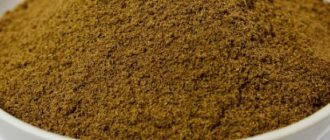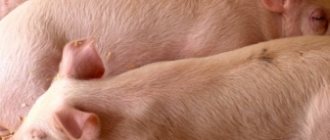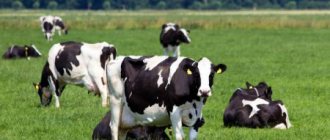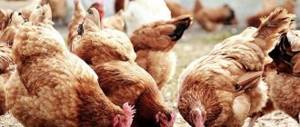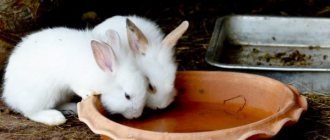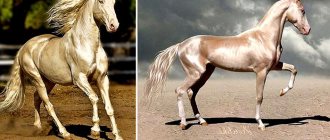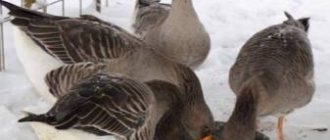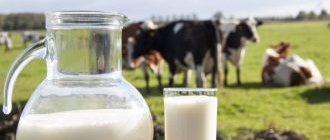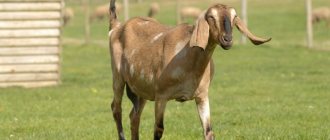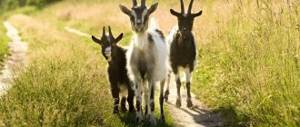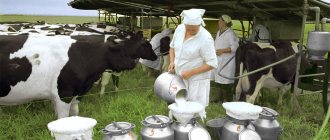Characteristics and breed standard
The Doberman is a fit and graceful dog with correct proportions.
Male height is 68-72 cm, weight is 40-45 kg. The female’s height is 63-68 cm, weight is 32-35 kg.
Color: black with red, blue with red, fawn (Isabella color) with red and brown with red.
- The tail and ears are traditionally docked, but some countries now prohibit docking and have different breed standards.
- The nose is black or brown, depending on the color.
- The oval eyes are dark, but light shades are also allowed depending on the color.
- The coat is smooth, short, and lies close to the body.
White Doberman or albino?
Speaking about colors, one cannot fail to mention white Dobermans. They appear to be albinos and are not recognized by most cynological associations. These dogs are not pure white, ranging in color from cream to ivory with white markings. Such Dobermans cannot be called albinos purely technically. Albinism implies the absence of pigment, but white Dobermans have pigment.
The first white Doberman puppy was born in 1976, it was a female. To fix this mutation, she was crossed with her son, and the son with her sister. Due to such inbreeding, many white Dobermans differ not only in appearance, but also in temperament. However, no one can say this with 100% certainty.
Diets for goats
Feeding the producers should ensure high sperm quality, good sexual activity and long breeding life. Inadequate diets lead to decreased sexual function in goats. The greatest impact is caused by deficiency of protein, iodine, phosphorus, cobalt, vitamins D and E.
Stud goats are maintained in factory condition throughout the year. To strengthen their physical condition, it is recommended to release breeding animals to pasture in the summer and into pens in the winter. The feeding regimen will differ for goats of different ages, degrees of sexual activity, breed and weight. Sperm maturation occurs in 1.5 months, so you need to prepare a goat for breeding 2 months before, gradually increasing feeding rates.
Diet of breeding goats depending on the daily load - the number of cages or semen collections
| Type of feed | Without load | 2-3 cages per day | 4-5 cages per day |
| Green mass, kg in summer | 5,5-6,0 | 5,5-6,0 | 5,5-6,0 |
| Mixed grass hay, kg | 2,0 | 2,0 | 2,0 |
| Legume grass hay, kg | 0,3 | 0,5 | 1,0 |
| Oat grain, kg | 0,2 | 0,3 | 0,5 |
| Barley grain, kg | 0,2 | 0,3 | 0,3 |
| Sunflower cake, kg | — | 0,2 | 0,2 |
| Skimmed milk, kg | — | — | 1,0 |
| Meat and bone meal, g | — | 10 | 10 |
In winter, roughage makes up up to 40% of a goat's diet. This is 2-2.5 kg of forb or legume-grass hay. A producer needs up to 2 kg of silage per day, as well as beets and other root crops. Be sure to include concentrates in the diet - even without a load of grain per day you need at least 400 grams for a large male weighing 70 kg.
During the period of breeding or sperm collection, rations are increased. The content of roughage and bulky feed remains practically unchanged, but concentrates are added. The grain rate is increased by 20-30%, cakes and meal are additionally fed, and skim milk is also given. It is important to give vitamin and mineral supplements.
Particular attention is paid to the quality of feed. Poor quality and spoiled products should not be given. Hay for goats is prepared only in the early phase of the growing season, when the plants are rich in protein, minerals and vitamins. Moldy, overdried hay should not be given to goats. Silage and haylage are checked for the level of acetic acid; it should be no more than 30% of all acids, and there should be no butyric acid in the feed at all.
How much hay does a goat need?
Goat farming is a popular livestock industry. These pets become an indispensable part of the household in areas with a temperate climate if simple rules of care and feeding are followed.
Daily norm
To produce nutritious and fatty milk and ensure good animal health per day, goats need:
- 4 kilograms – milking individual;
- 6 kilograms - goat;
- 2 kilograms for a kid.
The volume of hay may be diluted with chew additives, vitamins or grains.
For the winter
For adequate nutrition of one individual, from 400 to 600 kilograms of hay preparations for the winter period are required. The amount of reserves depends on the weight of the animal, sex and duration of the cold period.
Important! On average, one goat eats 120 kilograms of hay per month (4 kilograms for 30 days). However, when calculating the required supply, it is best to add an extra 100 kilograms on top.
Annual norm
Good animal care and a balanced diet for domestic goats are fully paid for by the milk they receive. Proper nutrition protects animals from the risks of digestive disorders and promotes the harmonious development of young animals. During the summer months, goats graze and replenish their need for grass while walking. During this period, diet enrichment is aimed at juicy additives, vegetables and fruits. The total volume of food consumed per goat is, on average, about 1.5 tons.
Important! It has been noticed that when vitamin E is added to goat food, the resulting milk becomes softer. Bitterness and sour taste disappear.
Feed requirements of an adult animal in winter
An adult animal requires 5-8 kg of green feed daily in summer, and in winter the weight of roughage is generally 1-2.5 kg per day.
Goats give preference to meadow, steppe or forest hay, dried young weeds from the garden, dry leaves of maple, rowan, oak, birch, harvested brooms (branches with young leaves), corn leaves, potato tops, beets, zucchini and pumpkin vines. You can feed spring straw of oats and barley. Steamed chaff is well eaten. Crushed young branches of coniferous trees can be given as a vitamin supplement.
An adult dairy goat with a milk yield of 2 liters of milk per day requires 400-550 kg of hay for the winter. If it is possible to prepare dry leaves (150-200 kg), branches in brooms (about 200 kg), garden waste and straw in the same volume, then the amount of hay can be reduced to 250 kg.
It should be taken into account that the nutritional value of additional roughage is almost 2 times inferior to hay.
Young animals from 6 months to a year require 300-350 kg of dry food in an assortment for the winter.
In addition to dried grass and branches, the diet of goats includes juicy root vegetables (fodder and sugar beets), vegetables (pumpkin, cabbage, boiled and raw potatoes, carrots, fruits), concentrated feed (cereals in whole or crushed form). It is better to give raw potatoes to young animals during the period of intensive growth, and boiled ones after lambing.
Daily diet of goats in winter
Mating of goats is usually carried out in the autumn, since the pregnancy lasts 5 months and the birth of kids is planned for the spring. The feeding diet in the first and second half of pregnancy is slightly different:
Hay should be given 0.5 kg per day. It is recommended to diversify the diet by alternating 1 kg of branch feed, 0.5 kg of corn stalks, 0.5 kg of leaves of trees and shrubs, 0.5 kg of straw from spring grain crops.
The total amount of roughage should be 1.5-2 kg per day. You should also alternate the daily intake of boiled potatoes (1.5 kg) and grain concentrate (400 g).
- In the second half of pregnancy, it is necessary to increase the amount of dry food (no more than 2.5 kg per day) and reduce the weight of boiled potatoes and concentrates so that the kids do not become too large and there are no problems during lambing.
- An adult goat needs 1 kg of cereal-legume hay, and 1.5 kg of grass hay per day;
for young animals up to one year old, grass feed - up to 1 kg;- It is recommended to add 300 g for young goats and 500 g for goats of concentrated feed;
- adult animals happily eat corn silage - 1 kg daily.
It is recommended to feed goats three times a day, trying to maintain the same amount of time between feedings. First, the animals are given swill (warm water with the remains of human food, concentrates), then juicy vegetables, and lastly, hay and other roughage.
On frosty days, you should increase the volume of concentrated feed so that additional energy will help you survive the cold season. If a goat produces more than 2 liters of milk per day, 0.5 kg of grain feed should be added for each additional liter of milk.
When raising downy and woolly goats, you should pay enough attention to feeding the uterine uterus: in November-December, goats develop a downy coat after molting. Therefore, during this period it is advisable to feed animals with high-quality hay:
Read also: Watussi bull: what it looks like, where it lives, what it eats
Feeding rules
In order for the goat to feel good and be productive, the following rules should be followed when feeding:
- in the morning it is recommended to give 50% of the daily requirement of hay;
during the day they feed roughage of medium and low quality;- In the evening, only high-quality hay is placed in the feeder at night;
- A goat's need for fluid is 3-4.5 liters per day;
- Each animal must be given salt, preferably in lumps, so that the goat licks it when needed.
The best hay for dairy goats and young animals is alfalfa. It is rich in calcium and protein.
For breeding bucks and pregnant goats, timothy and brome are suitable foods to feed. Barley and millet straw are better eaten.
Wheat, in turn, is poorly digested by the animal’s stomach, and many goats do not like rye. Brooms are prepared from young branches of poplar, maple, acacia, willow, and rowan. But the leaves of these trees are more readily eaten separately. The foliage of fruit trees and shrubs serves as a good vitamin supplement. Each farmer chooses what to feed his goats in winter, but the pickiness of these animals allows them to diversify their diet with less expensive feed.
How much hay does a goat need for the winter: where to get it
The goat is a ruminant animal.
Therefore, feeding her will not be difficult.
In winter, its main food is hay, and in summer, grass.
But besides this, additional complementary foods must be included in the diet of this animal.
It must contain essential vitamins. Dairy breeds produce up to eight liters of milk per day and, accordingly, spend a lot of energy. Therefore, it is necessary to feed the goat not only abundantly, but also correctly.
And for this, you need to determine: what quantity and quality of food is required and how much hay the goat needs for the winter.
How to prepare the required quantity
Before making hay, you should carefully study which herbs may be beneficial for your goat.
In some cases, a bitter taste may appear in the milk if there is wormwood, mustard or horsetail in the hay.
If a farmer mows his own hay, he should know that this should be done before the grass begins to flower.
At this time, they retain a whole storehouse of useful substances. After the grass has bloomed, it not only loses essential vitamins, but also becomes very rough.
Key points about mowing:
Video about how much hay a goat needs for the winter:
Health and health problems
Dogs of the Doberman breed are very energetic and even when a disease develops in them, these pets will not show their appearance until the very end about the existing problem. It happens that you can suspect something is wrong only at the most advanced stages, when your four-legged pet begins to lose strength. This breed is most often attacked by a disease called
Dilated Cardiomyopathy (DCM). This term includes diseases in which the heart muscle is subject to inflammatory attack, without obvious signs. It is the Doberman breed that is susceptible to this type of disease due to genetic predisposition and as a result of the harmful effects of toxins and infections in the dog’s body. Amino acid deficiency can also lead to DCM.
In the early stages, this pathology does not manifest itself in any way. The disease can progress from two to four years, completely asymptomatic. All this time, irreparable changes occur in the myocardium. The fibers become thinner, the ability to contract properly is impaired, the rhythm is disrupted and the chambers of the heart expand, which in turn creates problems with blood pressure, which can lead to problems maintaining the cardiac output.
The owner should be alert to: cough, shortness of breath and abdominal enlargement, apathy, loss of physical endurance, lethargy, lack of appetite, weight loss. These are the main signs of a progressive disease, and this stage can be fatal for a pet.
It is characteristic that males are more seriously ill than females and the pathology develops earlier in them, from about 8 months to 2 years, and in females from 5 to 7 years. This breed has a high percentage of sudden mortality, amounting to 25%. Males die more often.
Once the correct diagnosis is established and treatment is prescribed, the dog's life expectancy is short. Sick pets can survive up to 6 months.
Diagnosing CDMP using x-rays, which can reveal enlargement and expansion of the borders of the heart, venous congestion in the lungs, is not so easy. A more informative examination method is an electrocardiogram and echocardiogram.
Doberman dogs are the only ones who live for years with arrhythmias in the ventricles. This fact is sad because these pets are at risk of sudden death.
In order to avoid troubles associated with the health of your Doberman pet, disease prevention should be carried out. It is imperative that Doberman puppies undergo an echographic examination from the age of five months and properly protect the breed from genetic inheritance of the disease, i.e. Proper breeding.
The average life expectancy of Doberman dogs is low and is about 7-8 years. This is the very dawn of strength, but the terrible and hidden disease DCM makes its irreparable adjustments.
Unfortunately, in addition to the disease described above, Doberman dogs are also susceptible to dermatoses, demadecosis, allergies, and all types of staphylococcal infections.
Due to the cool climate of mid-latitudes, Dobermans suffer greatly from inflammation of the genitourinary system. This is expressed in a frequent and uncontrollable urge to urinate.
It is important to remember that the health of Doberman dogs directly affects their appearance, and the quality of nutrition determines the condition of the coat, which, by the way, is very hard, short and, with heavy shedding, is difficult to remove from the carpet and upholstered furniture.
How to make hay yourself
If a livestock breeder decides to mow and dry hay for winter harvesting on his own, you should pay attention to several rules:
- Wildflowers need to be mowed before flowering begins;
- cereal crops are mowed during heading;
- legumes - at the beginning of bud opening;
- Mow should be done on warm days after the dew has dried.
Experienced livestock breeders prefer to store hay on their own, as this process contributes to a careful selection of the components of the animal’s diet during the winter.
Summer diet
Of course, it is easier to feed a goat in the summer. On pasture, she eats up to eight kilograms of grass a day. But this supply is only enough for her to produce two liters of milk. Therefore, the animal should be fed with concentrates. For example, corn or legumes.
In summer, the grass in the meadows is very lush. But by the end of July it dries out; during this period the animal should be fed with vegetables and branches. With a good appetite, this animal eats food waste.
In addition to all of the above, a goat needs about twenty grams of salt. Which is approximately one teaspoon per head. It is better to use an iodized product.
So, the animal’s diet should include:
- Feed and bran in the morning.
- Grass in the meadow after milking.
- Compound feed and succulent feed in the evening. These include: cabbage, apples, carrots and the like.
- Some farmers give their animals a little hay at night.
- Drinking liquid should always be freely available. The animal should drink as much as it needs.
What to feed a goat in winter
In any season, the animal requires vitamins and nutrients. In the warm season, the goat gets most of it on the pasture, where there is a lot of fresh greenery. During cold weather, the herd is kept in pens, and the main food for this period is hay. Therefore, in winter it is necessary to include additional products containing vitamins and minerals in the animal’s diet. This will help maintain your pet’s health, increase productivity and improve the taste of “winter” milk. This will fully cover the cost of feeding your pets.
- High-quality feed is one of the main components of a goat’s proper diet. This means a product with a suitable shelf life, not damp and stored under proper conditions.
- Potatoes, cabbage, carrots, as well as beet and potato tops are often stored for the winter.
- During the cold period, vitamins will be provided by flour - bone or meat.
- Goats do not refuse leaves and branches; these products are also prepared in the summer. Together with hay, this type of food forms the basis of the winter diet.
Other types of feed
Despite the fact that goats are unpretentious in nutrition, they will not eat hay all winter. Therefore, you should stock up on different types of feed to diversify the animal’s diet.
Goats are great lovers of young shoots of fruit trees. They need to be stored in mid-summer, cutting off green branches 10-12 cm high, tying them into small brooms. Such panicles are dried in dry, ventilated areas, hanging from the ceiling.
Leaves from trees can also be used for food. The finished foliage is spread out in even layers and dried. Afterwards it is put into bags for further storage.
Read also: Structure of the digestive system of a cow
Don't neglect your other winter supplies.
Grains should be present in the winter diet of goats. The amount of consumption is determined individually, based on the age and sex of the animals. Do not forget that grain contributes to rapid weight gain, especially during stabling. This negatively affects the amount of milk.
Another important type of feed is straw. It is not so rich in vitamins and nutrients, but you can’t do without it. It is fed with bran or mixed with root vegetables. Oat straw with weeds is eaten with pleasure by goats.
For goats in winter, frequent changes in diet are desirable, so you need to stock up on a variety of feeds, which were listed above.
We strongly recommend that pregnant goats be given roughage alternately every day in order to avoid weight loss and get a healthy litter.
If you take care of the complete preparation of feed for the winter in advance, your animals will definitely thank you with good and tasty milk.
Storage rules
Like other organic products, if storage conditions are incorrect, hay can rot, rot and ultimately become unsuitable for goats.
Expert opinion
Zarechny Maxim Valerievich
Agronomist with 12 years of experience. Our best country expert.
Ask a Question
In winter, food supplies are especially important due to the difficulty of renewing spoiled food.
The basic rules for storing hay include:
- Dry thoroughly.
- Tedding compacted areas during drying.
- Prevents drying out.
- The presence of a spacious hayloft.
- Protection from moisture (rain, snow, damp soil).
- Full natural ventilation.
- Elevation above the ground (wooden logs).
Compliance with these simple rules will ensure the safety of harvesting until the next season.
How to store hay
After you have prepared hay for the winter, the main problem is how to store it so that it does not spoil. The first step for successful storage is to dry it thoroughly. Even slightly under-dried grass can deteriorate throughout the winter and become unsuitable for feeding.
It is best to store hay in specially built premises - haylofts. They must protect it from rain and snow, and also be equipped with sufficient natural ventilation so that the hay can get rid of excess moisture that may still remain in it.
Dry grass should not be stored on the ground, as it will absorb moisture from it. It is imperative to raise it above the ground; this is usually done by placing it on wooden logs.
If the hayloft is an open type, then the height of the roof must be adjusted in order to create ideal conditions for storing and drying dry grass.
Needs of goats depending on various factors
You need to feed a goat according to several basic rules:
- The larger the animal, the more it eats.
- When a goat is actively producing milk, it needs more nutritious food than dry food.
- During the first months of life, kids need mother's milk.
- A nursing goat should receive 1.5 - 2 times more food than usual.
- In winter, animals should have a higher fat diet to activate independent heating of the body.
- In the summer, goats need to eat plenty of carbohydrates and protein to generate energy for a long walk.
Alternative winter feeds and diet supplements
The nutrition of goats affects not only the general condition of the animal, but also the quality and taste of the milk obtained. In order for the animals to receive the full range of vitamins and microelements, and also to strengthen the chewing apparatus, the goat breeder needs to prepare:
- young branches of trees and shrubs (raspberry, apple, willow, pear, beech, maple, birch, oak, linden);
- willow bark;
- fir branches;
- dry leaves;
- grain crops (oats, barley, corn, wheat);
- vegetables, root vegetables (fodder beets, carrots, fresh potatoes, pumpkin, zucchini) - no more than 3 kilograms (for an animal weighing 50 kilograms) per day;
- field herbs (chamomile);
- straw (barley, oat);
- vitamin supplements (check with your veterinarian).
Important! Despite the usefulness of grain crops, an excess of this product can lead to a rapid increase in the weight of the animal and a decrease in milk production
What not to feed
Goats are not the most demanding animals to care for, but not all plants are suitable for their food.
The following cannot be taken into stock:
- celandine;
- dope;
- Red clover;
- nightshade;
- wild rosemary;
- milestones;
- lily of the valley;
- cicuta;
- parsnip;
- hogweed;
- lupine;
- ferns;
- hellebore;
- thistle;
- bristlecone;
- feather grass (tyrsa);
- trailer;
- sprouted potatoes;
- flax cake, mustard, rapeseed, camelina, rapeseed, hemp.
Care must be taken when selecting plants to feed goats. Otherwise, poisonous plants cause gastrointestinal disorders or death of the animal.
Important! Disruption of the digestive system of goats is also caused by chaff and grain husks, sawdust or sand that get into the animal enclosure if sanitary conditions are not met.
Reviews
it depends on what kind of goat and what kind of hay... I bought 1.5 tons for my 4, but there will also be brooms, dried nettles, and straw. Something like that. Personally, I use about 300 kg of hay per season
babushka-11
https://forum.kozovod.com/t/skolko-sena-nado-odnoj-koze-na-zimu/3611/2
Was this article helpful?
Thank you for your opinion!
Write in the comments what questions you have not received an answer to, we will definitely respond!
You can recommend this article to your friends!
Already helped 112 times
Slot feeder for goats.
The dimensions of the feeder itself can be arbitrary and depend on the available area of the cage. The main thing that needs to be provided is that there is a sufficient hole in the upper cutout for sticking its head into the feeder, and the lower cutout should be such that the goat, having lowered its head to the hay, cannot stick its head back through the lower cutout. She will be forced to eat hay with her head constantly stuck into the feeder. Having had enough, she will raise her head again and move away from the feeder. With this feeding method, hay is not scattered throughout the cage. This is a very economical design.
Each door has an opening where the goat can stick its head out and watch the actions of the mistress, who scatters thick mash on the passage before feeding.
If there is no such hole, then the goat will stand with its front legs on the fence to observe what is happening on the passage. This has a bad effect on the goat, especially on the pregnant one .
Goats are very curious and sympathetic creatures. They have such positive energy that they can successfully replace any psychotherapist. Every time you leave them, you feel at ease, although before that, your head was full of worries and heavy thoughts. It only takes a few minutes to chat with them to get a positive charge for the whole day.
Each door has an opening where the goat can stick its head out and observe the actions of the mistress.
Our goat milking schedule is such that one milking occurs at one in the morning. The wife says that she is going to them as if on a holiday, although all normal people are already asleep. She opens the door of the goat house, and she is already greeted by heads sticking out into the corridor, and each head makes its own sound of joy. Mutual happiness! It's nice when you know that someone is waiting for you.
What is the amount of hay for a goat?
If we take 2-2.5 kg of hay per day as the norm, then it is not difficult to estimate the required amount for the winter for one goat. Each region has its own stall period and each barn has its own feeding ration.
It's better to have some hay left than not to have enough hay. In the spring, on lush grass, goat hay is simply necessary to balance the fluid ratio and prevent diarrhea from excess water in the body. A violation of the liquid coefficient is also observed when a glass of flour is poured with three liters of water and the goats are fed with such swill. For the sake of flour, the goat drinks all the water. The kidneys cannot cope with the removal of such an amount of fluid and the goat constantly has a liquid mass floating from under its tail, which should come out like peas. We don’t eat only first courses, washing them down with compotes. We also need a dry component in our diet. For spring grass, hay for a goat will be very useful.
“What to feed a goat in winter? Harvesting hay. Photo of the butcher shop.” - HERE.
Closer to spring, even if there is plenty of basic hay, we slowly begin to feed the hay that was on the ceiling of the goat barn. It does not have any repulsive odor, because... It’s dry in our goat house.
Goats are not particularly afraid of frost if they are in a dry room. This is the reason why we keep goats on deep litter.
What should a winter room be like?
Most goat breeds are not very heat-loving animals. Individuals do an excellent job of regulating their body temperature even in very severe frosts.
If we are talking about woolly or downy goats, then the owners of such animals should not worry too much about their safety when frost occurs. Those with thick fur are practically immune to low temperatures.
The only danger for goats comes from excess humidity and drafts. The presence of wind indoors can lead to outbreaks of pneumonia among animals (this is the disease that is very often diagnosed in goats under inappropriate housing conditions). Ungulates must have good shelter from precipitation and drafts, but not too tight, because fresh air must enter the room.
Example of a goat room
In most cases, it makes no sense to install a special heating system in the goat house. But during the lambing period it is worth taking care of the presence of heating in the room. Newborn kids should have good protection from sudden changes in temperature.
During the winter months, the temperature in the goat room should be +6-7°C. For lambing queens and their offspring, this figure rises to +8-10°C.
Most often, the flooring in a goat house is made of planks. The premises are divided into individual pens, where nurseries for roughage are installed, as well as separate containers for concentrates and root vegetables. Watering is carried out from automatic drinkers or buckets. The containers must be installed in such a way that the goat does not have the opportunity to turn the drinker over and has constant access to water.
What to feed a goat in winter
A goat's diet in winter should consist of several essential parts. Each feed part introduces the necessary nutritional components into the animal’s body.
Roughage
Includes such types as hay bales, grass meal, straw, leaves, knots. A goat's winter diet should include hay. Its preparation occurs at the moment when the buds of the legume family begin to set and cereal panicles appear. Legume-cereal hay is the best option for feeding; you can also add forbs here.
You should not pay attention to the types of cereal crops, since hay can be dried both in an open field and in closed special rooms. An indicator of high-quality cereal is humidity, which reaches 17%
It is necessary to monitor the hay so that its moisture content does not exceed normal limits, since with strong drying it loses all its minerals and nutrients.
Before drying the hay, you need to decide on its quantity, since one goat requires half a kilogram of feed per day, and in a year it eats about 400 kilograms. When a goat is pregnant or producing milk, consumption increases to 2-3 kilograms per day. And at the end of gestation, the volume decreases.
If there is no hay, then we can easily replace it with straw. The daily norm is 2 kilograms. Thanks to the vitamin substances present in the straw, goats quickly gain growth and produce excellent offspring. Not all substances are present in dry food, and to make more of them, cut pieces of 2-3 centimeters each, soak them in a saline solution in a ratio of 6 liters per 10 kilograms of the total volume of food.
Thin branches should also be included in the goat's diet. The best option is to make brooms out of them. Here you can use coniferous and deciduous trees. Goats hold in high esteem: aspen, oak, birch, maple, rowan, linden. There is also spruce, but you shouldn’t add a lot of it to your diet; it’s better to give it in limited quantities. Branch food is designed for the whole day - about 450 grams.
Juicy feed (silage)
It is the main thing in a goat’s diet, since thanks to it it can produce a large amount of milk, and it is also beneficial for the health of the animal. Suitable for making this type of food:
- beet and carrot tops;
- legume mixtures and cereals prepared during the development of the cereal plant;
- grown millet and rye during ear formation;
- ripe waxy corn;
- soy;
- harvesting during flowering of clover, sweet clover and alfalfa.
The preparations are made in the following way: we grind the ingredient, then put it in plastic bags, compact it and keep it. Humidity should not exceed 75%.
Juicy food has a pleasant smell and is quickly eaten. The daily norm is from 2 to 3 kilograms.
Vegetable feed
Additional auxiliary components included in goat feed are root fruits and vegetables. They are very nutritious, have a large amount of water, which has a great effect on increasing milk yield. The components contain useful vitamins and substances, due to which the stomach works like a clock. Before feeding the goat root fruits, they should be carefully processed.
The most popular food is raw potatoes. But before giving it to the goat, the vegetable should be boiled, then it will become the most nutritious. And raw potatoes contain corned beef, which is very harmful to the body. Vegetable feed should be given from 2 to 3 kilograms per day.
Concentrated substances
It is necessary to feed the goat with concentrated substances in winter. The daily food ration contains protein, carbohydrates, fats, vitamins and minerals.
Concentrated substances include:
- cereals that contain carbohydrates;
- bean grains containing proteins;
- an oilseed plant that contains fats and proteins;
- waste grain and various foods;
- powdered milk;
- bone meal;
- fish flour;
- various feedstuffs.
The grains are best mixed with other types. Due to this, the goat’s body will develop the necessary balance of amino acids, carbohydrates, fats, and proteins.
Before serving food, it is necessary to carry out processing in advance.
Name for a dog - how to choose?
Pedigree puppies are given special nicknames. The kennel or club must give all puppies in the litter nicknames starting with the same letter. Nurseries have a system that determines which letter to choose. Most often they go in alphabetical order, excluding letters that cannot begin a word.
The name of the father or mother, as well as parts thereof, are not included in the puppy’s name. For puppies from nurseries, the name of the nursery is added to the main nickname, for example: Louise from Sosnovy Bor. The nickname can be repeated once every 30 years.
Since it is often difficult to come up with 6-8 digestible nicknames for one letter, it happens that hard-to-pronounce names appear that are not so easy to use to call a dog on the street. The owners usually come up with a pet nickname, since it is impossible to change the name given by the club or nursery.
It is desirable that the nickname be short, clear and sonorous. There is disagreement about the letter “r”: some say that it provokes the dog’s aggression, since the sound is similar to a growl; others are sure that imitating the sounds dogs make, on the contrary, makes them better accept the nickname.
The Doberman is a large and proud dog; it is advisable that the name matches the appearance of the animal. For females, names such as Wanda , Gloria , Darra , Ursula , Evita . For males - Bundy , Barker , Woland , Drago , Lark , Fry . Give free rein to your imagination!
Harvesting hay for the winter for a goat: how much is needed and how to feed it correctly
A goat is a ruminant animal that requires roughage for normal digestion. In the summer, when grazing, she eats green grass, covering her nutritional needs.
For the winter, for its complete diet, it is necessary to prepare hay.
The animal's diet should be diversified with dried branches of trees and shrubs, juicy vegetables and fruits, grains, and silage. The winter stall period lasts 6-7 months depending on the climatic zone and weather conditions.
Calculation of how much hay a goat needs for the winter is made taking into account the following factors:
- direction of breeding (meat, wool, down, dairy);
breed;- animal productivity (amount of milk per day, wool clipping, weight gain, down combing time);
- age and condition (pregnancy, after lambing, dairy or fattening animals, dairy goats, breeding goats);
- the farmer's ability to diversify the diet.
In the winter-spring period, small kids are born, which need to be accustomed to roughage from 2-3 weeks of age. Therefore, if the volume of hay for a pregnant female is calculated, the required weight should be added to the kids, of which there are up to 5 in a litter.
Other food
It should be understood that the animal cannot chew only hay throughout the winter period.
Their diet needs to be diluted. Many people use straw as rough feeding.
But mainly it is needed for bedding.
This animal loves to eat twigs.
Therefore, it makes sense to stock up on them in advance. It is better to do this in mid-July. To determine which tree is best to use, it is best to let your goat try several types.
She will choose what she likes best. Then all that remains is to cut the branches, tie them into bundles and hang them in a dry shed.
You can also collect leaves from trees. Just make sure they don't rot. Therefore, they need to be stirred periodically. They should be stored: spread out in a thin layer in a dry place. After complete drying, they are placed in special bags until the onset of cold weather.
By stocking up in this way, you can stock up on good nutrition for the goat throughout the winter. In addition, the animal is fed grain crops. But each animal owner has the right to decide for himself how much grain to give. You shouldn't overfeed goats either. They quickly gain weight, and their productivity decreases accordingly.
Read also: Goat does not come into heat: ways to stimulate heat
If you have a large garden, you can stock up on various vegetables for the winter. This will only have a positive effect on the quantity and quality of goat milk.
One dairy goat will need about three hundred kilograms of hay in the winter; males require increased nutrition, so you need to store one and a half times as much hay for it.
As for kids, they require about 1.5 kilograms per day. The farmer must understand that for adequate nutrition he will also need complementary foods in the form of vegetables, leaves and branches.
Arrangement of winter walking
Goats are active animals, and therefore they need a designated place for walking. The ability to run and play with each other allows the ungulates to keep themselves in good shape, and such walks have a positive effect on the amount of milk production.
Winter walking for goats
A walking yard is being built next to the animal premises. It is worth considering that hard snow and ice often get between the hooves of goats; if removed untimely, they are a source of pain, which often leads to hoof injury. To prevent such problems, it is recommended to inspect the goats' limbs when returning from a walk. Also in winter it is worth removing snow and ice from the walking yard.
